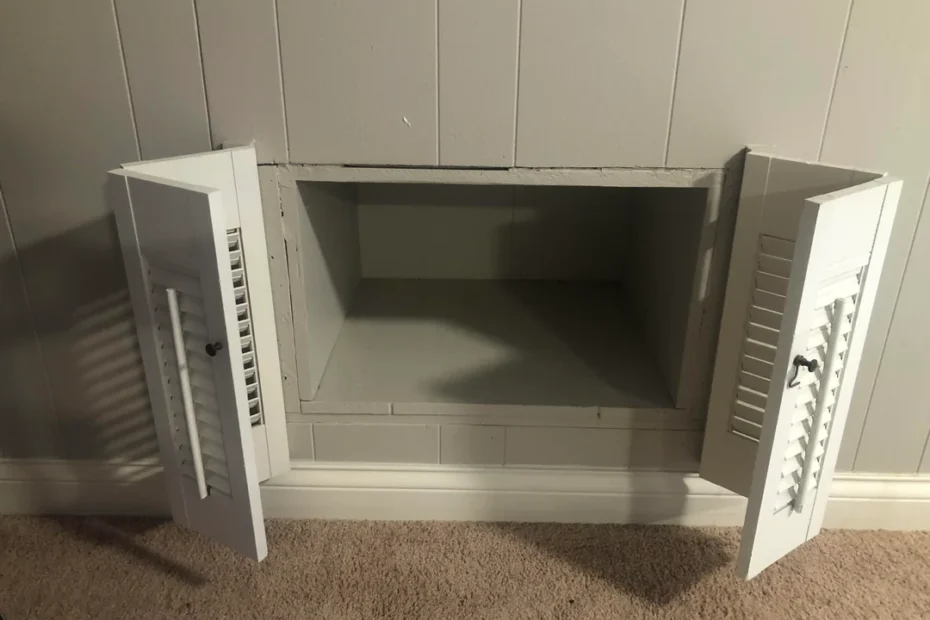A questioner said:
What is this thing in my friend’s new home. House in Tennessee built 1956. Small cubby, in master bed, with shutter style doors. Measures ~w24” x t13” x d15”. It extends out to the back porch.





More from the owner: “As stated, it’s in the master bedroom, along the wall that shares a door to the back porch. Just moved in, no one here knows what it’s for. Perhaps it was used to store firewood? There is a fireplace in the house.. but that’s my only guess.”
Some of the people opinions on it were:
matthewfrancisphoto said: Milk/dairy delivery box
Read More: Mysterious white under kitchen cabinet bracket in my 1980’s era home! Any idea?
When my friend invited me to visit their newly acquired home in Tennessee, I was excited to explore its mid-century charm. Built in 1956, the house is a testament to the era’s architectural style, blending functionality with unique design elements. As we wandered through the rooms, one particular feature caught my attention in the master bedroom—a small cubby with shutter-style doors.
The Cubby: An Architectural Curiosity
Tucked into the corner of the master bedroom, the cubby measures approximately 24 inches wide, 13 inches tall, and 15 inches deep. At first glance, it seemed like a quaint storage space, possibly for linens or small personal items. However, its design and positioning hinted at a more intriguing purpose. The cubby extends outward to the back porch, creating a direct but hidden passage between the indoors and outdoors.
WITT: The Hidden Feature
Upon closer inspection, we realized that this cubby was not just a storage space—it was what locals and historical enthusiasts often refer to as a “WITT.” WITT, short for “Window in the Tub,” is a rare and ingenious feature found in some mid-century homes. These small, shuttered compartments were designed to allow homeowners to receive deliveries directly into their homes without stepping outside.
In the context of my friend’s home, the WITT served as a practical solution for various needs. During the 1950s, it could have been used for receiving groceries, milk deliveries, or even laundry services. This design allowed for privacy and convenience, especially on days when homeowners preferred not to leave the house.
Architectural and Historical Significance
The discovery of the WITT in my friend’s home highlights the innovative spirit of mid-century architecture. This period was marked by a focus on simplicity, functionality, and a seamless connection between indoor and outdoor spaces. The use of shutter-style doors not only adds to the aesthetic appeal but also provides a functional element of privacy and security.
Moreover, features like the WITT reflect a time when home design was heavily influenced by the practical needs of daily life. In an era before modern conveniences such as online shopping and delivery services, having a discreet, secure way to receive goods was a significant advantage.
Preserving and Celebrating the Past
For my friend, discovering this unique feature in their new home has sparked a deeper appreciation for its historical and architectural heritage. They plan to preserve the WITT and incorporate it into their daily life, perhaps even using it as a charming way to receive packages or as a quirky conversation starter for guests.
This small but significant detail serves as a reminder of the thoughtful design principles of the past. It also underscores the importance of preserving architectural history, allowing us to appreciate the ingenuity and creativity that have shaped our living spaces over the decades.
In conclusion, the WITT in my friend’s Tennessee home is more than just a hidden cubby. It is a window into the past, offering a glimpse of mid-century life and the practical innovations that made everyday tasks a little bit easier. As they settle into their new home, this delightful discovery adds a layer of historical richness, making their mid-century house not just a place to live, but a treasure trove of stories waiting to be uncovered.
